CYCLING ADVENTURE IN
MOROCCO
WHAT TO EXPECT?
The adventure is divided into 5 cycling stages.
Each stage starts and ends in Riad (our hotel), which means all belongings stay in one place. For each day’s ride, only a small (lightweight) backpack is taken along, containing essential items, including lunch (packed in a box).
Each route section is unique and different from the previous day’s stage. On average, each stage is about 50 km long. It is possible to skip a stage if needed.
Be prepared for both ascents and descents every day—some days more, some days less. Morocco is a very mountainous country, so it won’t be possible to ride on flat terrain for long stretches during this adventure. Most of the route consists of smooth asphalt roads with minimal car traffic.
===================
BICYCLES
At the beginning of the cycling adventure, each participant receives a mountain bike that is appropriately sized. All bicycles are standard models and are in perfect working condition at the time of handover.
If a participant wishes to personalize the bicycle (to make the ride more ergonomic and as similar as possible to what they are used to at home), we recommend bringing personal accessories from their own bike—such as a saddle, clipless pedals with cycling shoes, bike rack with panniers, speedometer, handlebar extensions, lights, water bottle, helmet, cycling shorts, gloves, etc.
For an additional fee, MTB e-bikes and child seats are also available.
===============
ON-ROAD ASSISTANCE
The adventure is guided by knowledgeable and experienced cycling guides who not only lead the way but are always ready to help solve any cycling-related issues.
Common problems (such as a flat tire) are resolved on the spot. In case of more serious incidents (such as a fall that prevents further riding), we have an emergency vehicle team that arrives at the scene as quickly as possible to assist and resolve the issue (including evacuating both the participant and their bicycle, if necessary).
Before traveling to Morocco, we strongly recommend that each participant obtains appropriate health insurance that covers this type of adventure.
• One-week adventure in Morocco – from 545 EUR
• Meals (7x breakfast, 7x dinner, 5x lunch)
• 5x TRX & stretching sessions
• 5x unique cycling routes (approximately 50km per day) + bicycle + helmet
• 1x Trekking to Tamraght mountain
• 1x Trekking to Taghazout
• 1x Trekking to Aourir
• 1x Moroccan tagine cooking class
• Excursion to Paradise Valley and visit to argan oil cooperative
• 1x Moroccan hammam visit
• 2x Agadir airport transfers
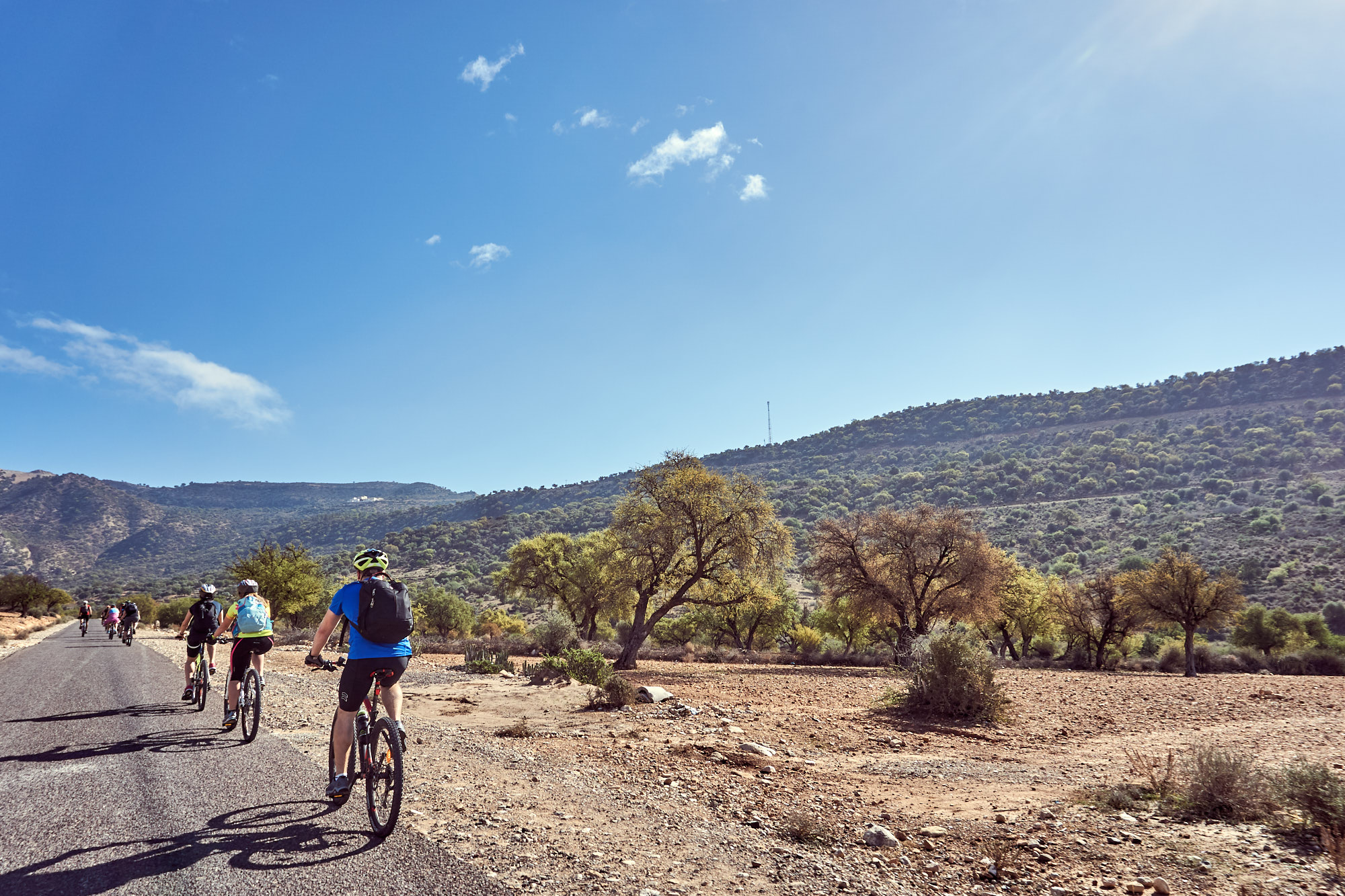
DATES
FEBRUARY 21. - 28.02.2026.
FEBRUARY 28. - 07.03.2026.
MARCH 14. - 21.03.2026.
MARCH 21. - 28.03.2026.
APRIL 25. - 02.05.2026.
MAY 02. - 09.05.2026.
MAY 16. - 23.05.2026.
MAY 23. - 30.05.2026.
MAY 30. - 06.06.2026.
JUNE 13. - 20.06.2026.
JUNE 20. - 27.06.2026.
AUGUST 22. - 29.08.2026.
AUGUST 29. - 05.09.2026.
SEPTEMBER 12. - 19.09.2026.
OCTOBER 17. - 24.10.2026.
OCTOBER 24. - 31.10.2026.
NOVEMBER 07. - 14.11.2026.
NOVEMBER 14. - 21.11.2026.
NOVEMBER 21. - 28.11.2026.
NOVEMBER 28. - 05.12.2026.
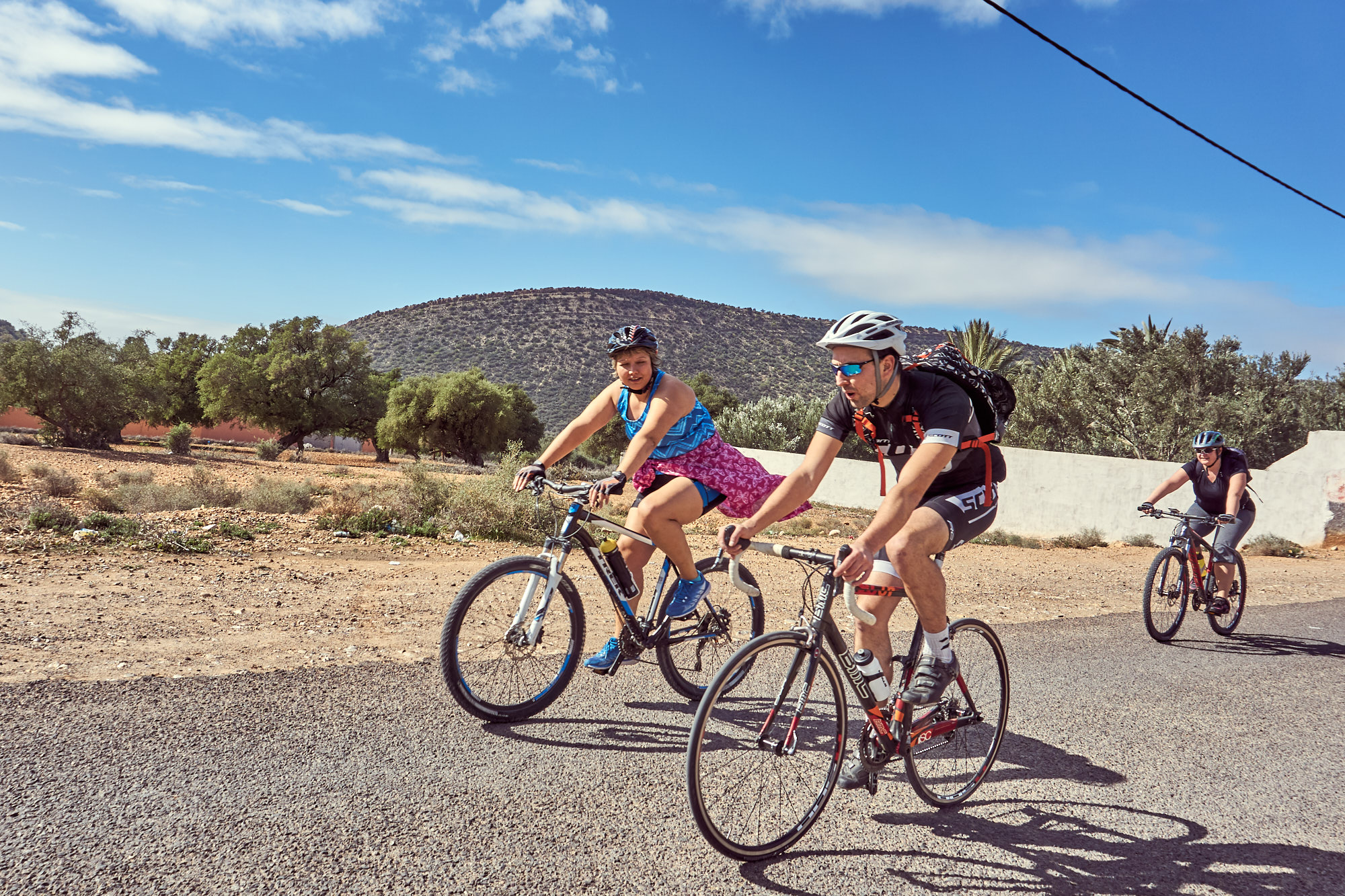
PARTICIPANTION FEE
The participation fee for the cycling adventure depends on the type of room the participant wishes to stay in:
545 EUR* | quadruple room (mixed gender)
Price per one bed (per person).
575 EUR | double room
720 EUR | private single room.
Included in the price:
Accommodation (7 nights); meals (7 breakfasts, 5 lunches, 7 dinners); morning workouts (5 sessions); cycling days (5 unique routes); bicycle and helmet; trekking to Tamraght mountain, Aourir, and Taghazout; excursion to the argan oil cooperative and Paradise Valley; Moroccan tagine cooking class; Moroccan hammam visit; transfers (to/from Agadir airport/bus station).
Not included in the price:
Travel to and from Agadir (including flights); free day activities; travel insurance; alcohol; souvenirs.
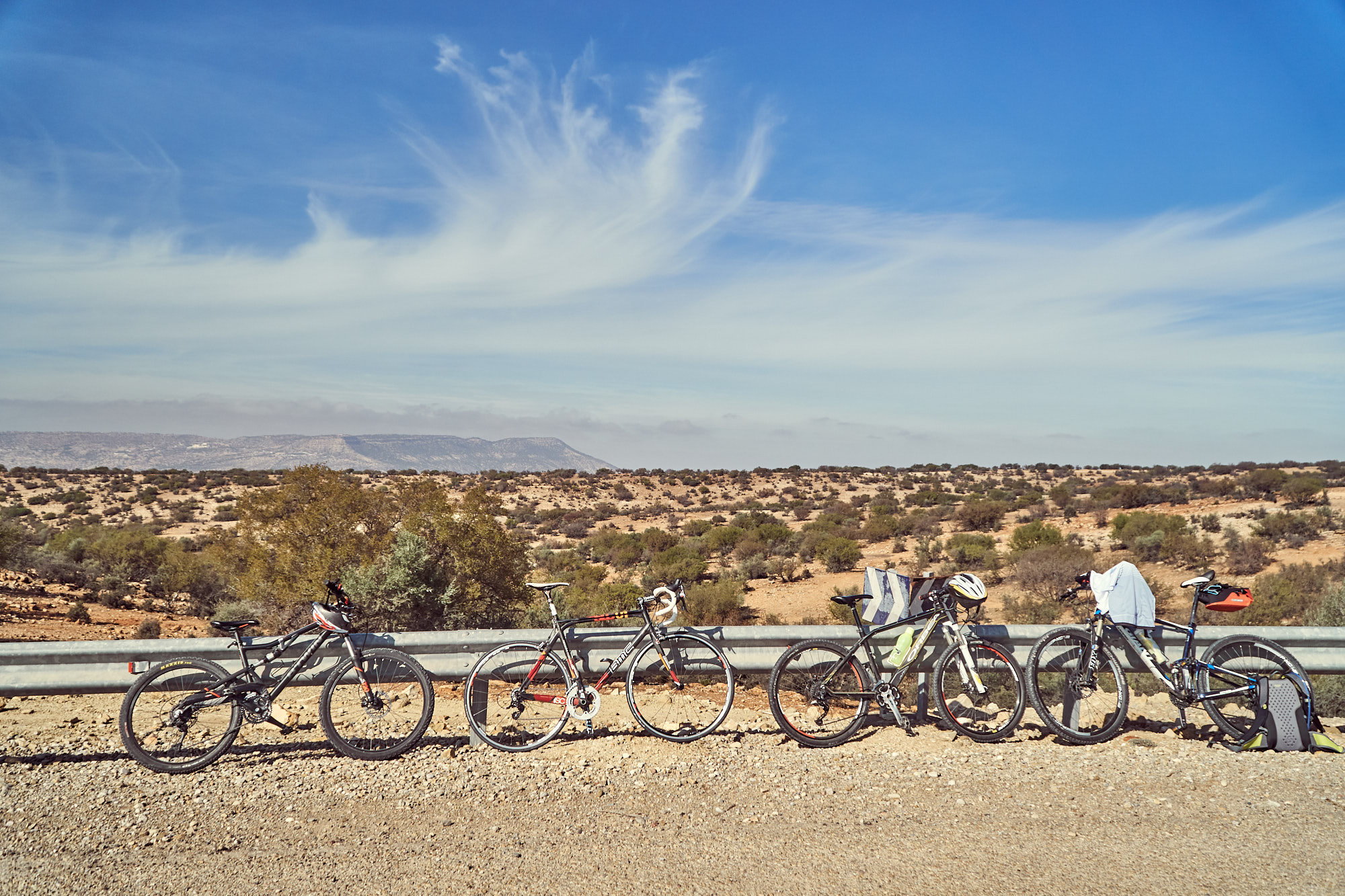
PLAN FOR THE DAYS
DAY 1 | ARRIVAL: AGADIR
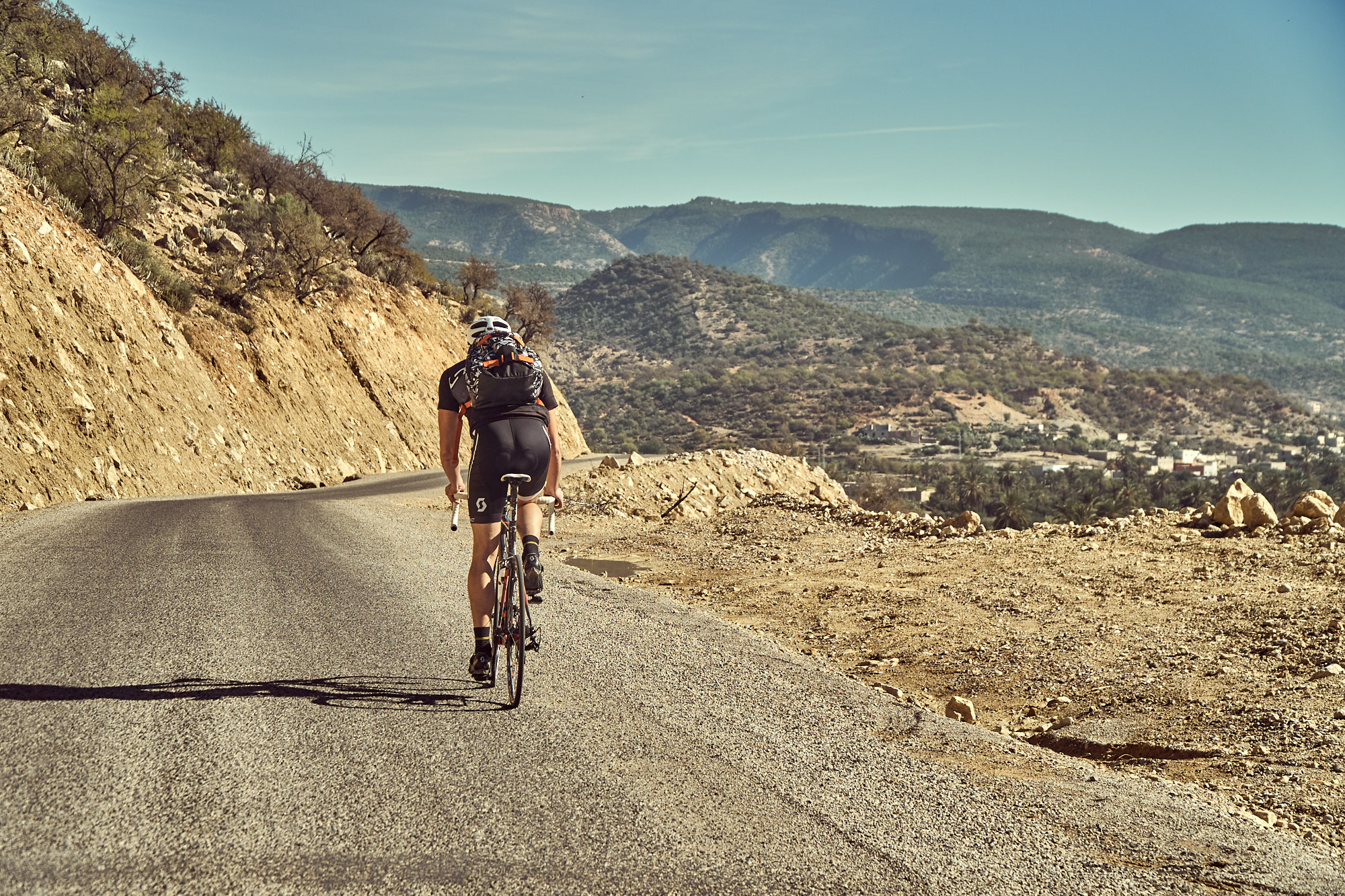
DAY 2
At 8:00 AM we get up for morning TRX & stretching. After breakfast, we prepare the bicycles and set off on our first day’s cycling route. In the afternoon, we return home and go trekking on Tamraght mountain, which is visible from the house. | [B, L, D]
TAMRAGHT MOUNTAIN
Morocco is a very mountainous country. Larger or smaller mountains are everywhere here. We also have our own mountain in Tamraght—Tamraght Mountain. Although it is a very insignificant point on the map of Morocco, its height is comparable to the highest mountain in Latvia—310 meters above sea level.
This mountain in Tamraght is visible from almost every house window. From the top of the mountain, you can see nearly every house in Tamraght—and much more.
From the summit, there is a stunning view of our village and the Atlantic Ocean. A little further north, Taghazoute is visible. To the south lies Aourir, and beyond it, in the distance, Agadir can be seen.
Tamraght Mountain is the perfect place to start this Moroccan adventure. Climbing it gives you an understanding of the village where you will spend the next week, as well as the layout of nearby towns, their sizes, and the scale of the region as a whole.
Trekking total distance: ~4 km
Vertical ascent: ~200 m
Trekking time (moving): ~1 hour 20 minutes
Total trekking time (including breaks, photos, enjoying the view): ~2 hours 30 minutes
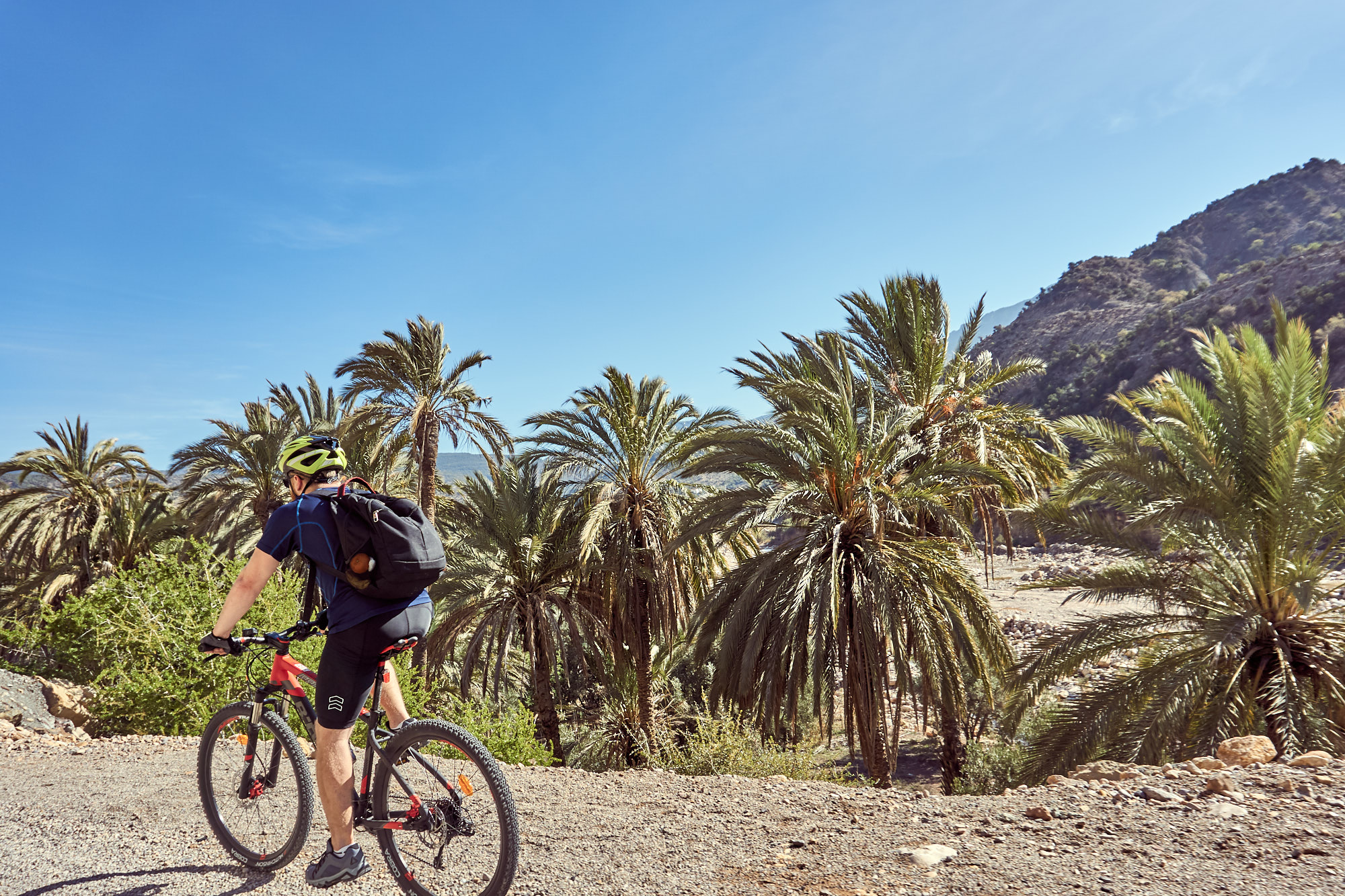
DAY 3
TAGHAZOUT
A colorful village on the Atlantic coast, located 5 km north of our home.
Taghazoute, once a tiny, unknown, typical Moroccan village (one of thousands like it), has become not only a nationally recognized tourist destination but also a world-class resort.
Taghazoute’s success story began in the late 1960s when the first surfing enthusiasts from Europe and America started arriving.
Back then, “surfing enthusiasts” and “hippies” (in the Moroccan context) were synonymous. They needed very little—traveling with a backpack on their shoulders and a surfboard under their arm. They lived in tents or simple, homemade straw huts. They smoked Morocco’s “chocolate” and spent the winter in a million-star hotel with a direct view of the ocean.
Thanks to the warm and sunny climate that prevails here year-round, as well as the constant (and large) waves, this place gradually became more and more popular among surfers.
In the 1990s, with the emergence of low-cost European airlines, Taghazoute experienced its first “boom.”
Living in tents was banned, and the first simple guesthouses and cafes began to appear. Taghazoute became increasingly popular among surfers, though it remained largely unknown to other tourists.
At the start of the 2000s, the Moroccan government finally recognized Taghazoute’s potential and declared it a national tourist destination, investing countless millions in its development. New roads were built, along with much more luxurious hotels and cafes. New shops opened. Activity offerings expanded beyond surfing—such as camel and horse rides. On the beach, it became possible to rent umbrellas and sunbeds. The internet arrived. Slowly (and irreversibly), Taghazoute also became interesting to tourists who are not surfers or hippies.
Just when it seemed Taghazoute had been fully built up, right after COVID, several world-class 5-star hotels opened their doors for luxury seekers—including Hilton, Fairmont, Hyatt, Riu, Radisson, and others.
Today, Taghazoute is a truly multicultural place where, 365 days a year, you can meet surfing enthusiasts from around the world as well as those with no interest in surfing at all. These visitors come to Morocco’s surfing Mecca to enjoy luxury rather than for the reasons that originally sparked the region’s success story.
Trekking total distance: ~11 km
Vertical ascent: ~50 m
Trekking time (moving): ~2 hours 10 minutes
Total trekking time (including breaks and photography): ~3 hours
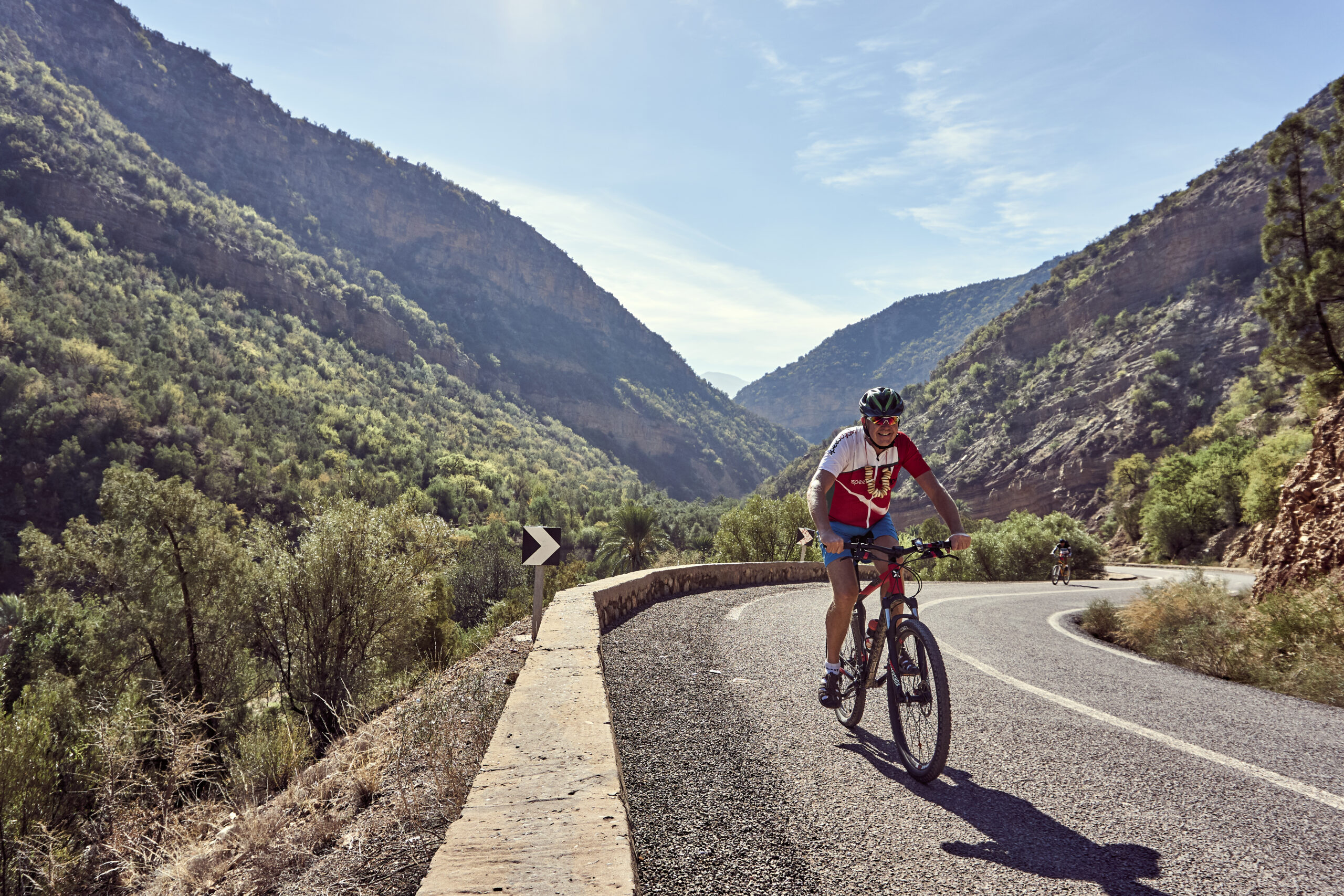
DAY 4
AOURIR
A small town on the Atlantic coast, located 4 km south of our home.
Aourir doesn’t have the success story of Taghazoute. However, being relatively close to it, Aourir has also experienced noticeable demographic and economic growth in recent decades.
Geographically, Aourir is situated at a crossroads between the region’s only large city—Agadir—and many mountain and coastal villages.
From its beginnings, Aourir has been a farming village, widely known as the “Banana Village” because many of its residents actively cultivate bananas.
As a result, Aourir has always been the place where a true Berber market literally “blooms” every week (on Wednesdays). Historically, people from all the surrounding villages—near and far (including Tamraght and Taghazoute)—have traveled here to buy products (mainly fruits, vegetables, meat, eggs, and more) for the entire week.
In recent years, urbanization has transformed Aourir from a small village into an important regional town, currently home to about 30,000 people.
Many families from the region’s mountain villages have moved to Aourir because of job opportunities. Many live in Aourir but work in Tamraght, Taghazoute, or even Agadir.
Aourir has everything: various shops, cafes, guesthouses, banks, doctors’ offices, hair salons, schools, auto repair shops, and a gas station. If you can’t find something in Tamraght or Taghazoute, you will definitely find it in Aourir.
Trekking total distance: ~8 km
Vertical ascent: ~110 m
Trekking time (moving): ~1 hour 50 minutes
Total trekking time (including breaks and photography): ~3 hours
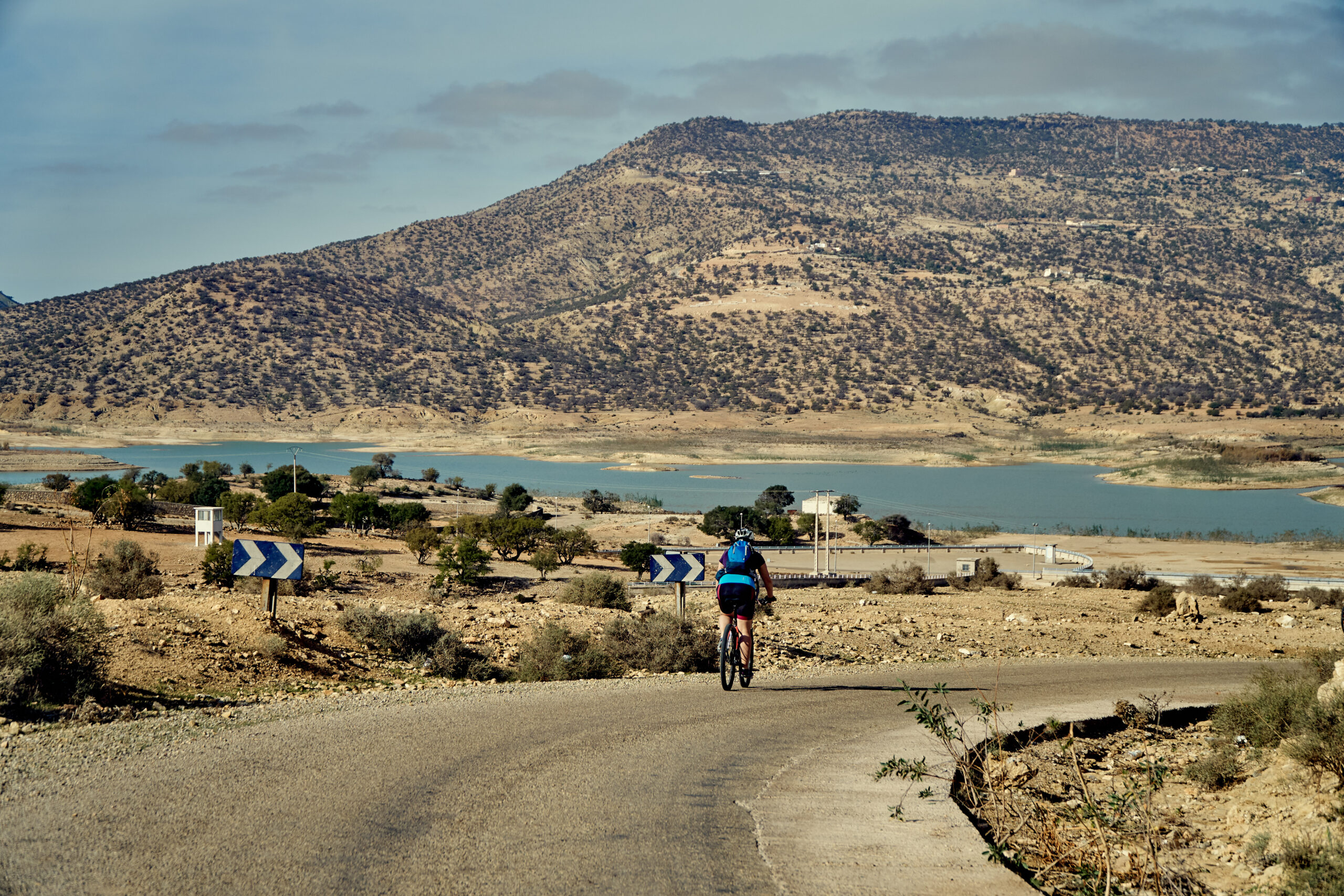
DAY 5
TRX & stretching + Day 4 cycling route. In the evening, we will participate in dinner preparation ourselves—under the guidance of a Moroccan hostess, there will be an opportunity to watch and ask questions in a tagine cooking masterclass. | [B, L, D]
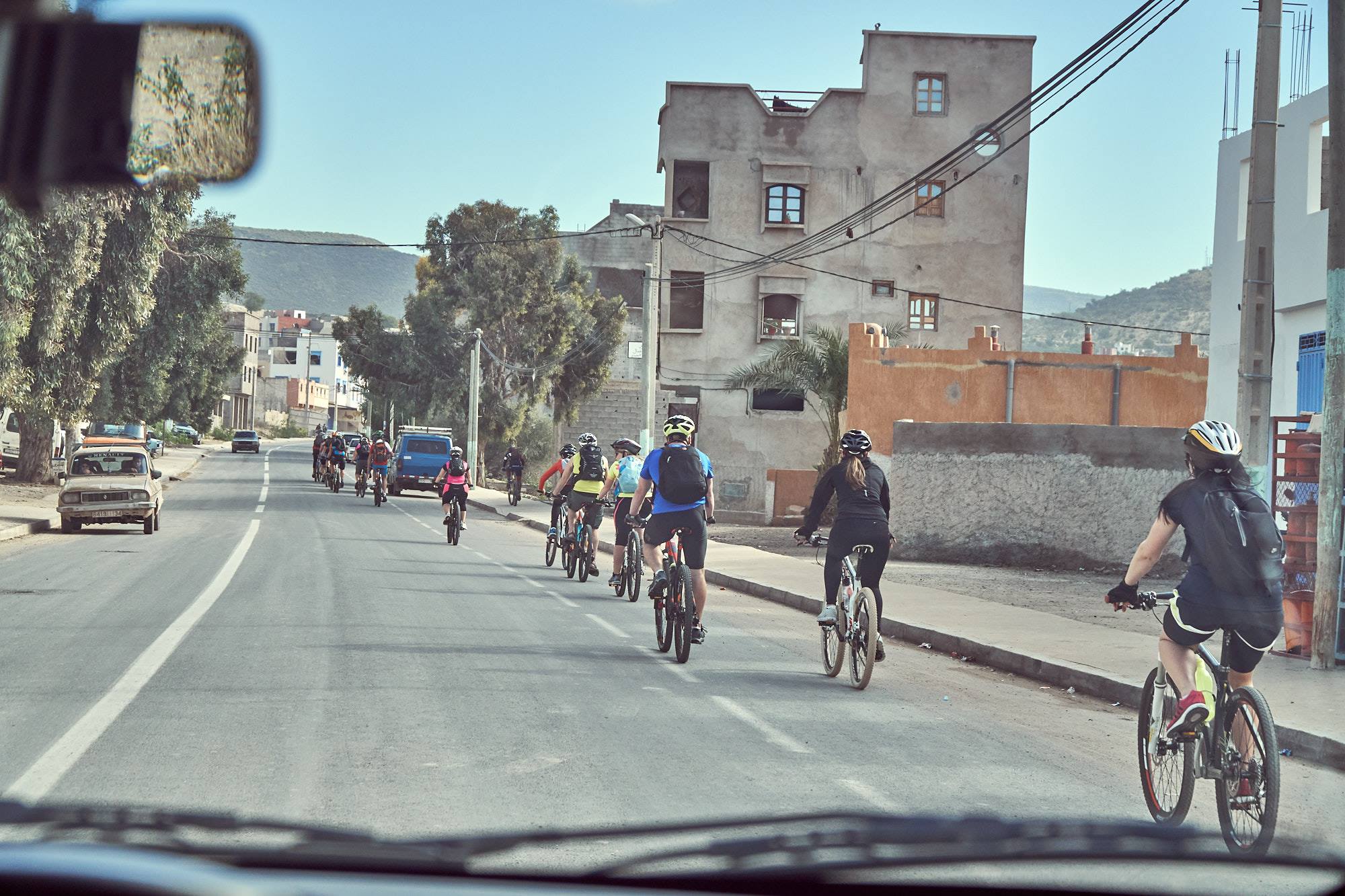
DAY 6
PARADISE VALLEY
In the 1960s, this valley became a popular gathering spot for hippies. Legend has it that a seriously ill German couple once came here, spent six months in the valley, and fully recovered. Upon returning home, the Germans said they had been healed by the “Paradise Valley.” This is where the name of the place originated.
This charmingly beautiful and green valley, stretching 7 km along the mountain stream Ankrim, is an ideal place for a light mountain hike. Passing by banana, fig, and olive trees, date palms, and countless other plants, a pleasant trail winds along, which after about 3 km of walking leads to a spot that can safely be considered the heart of “Paradise Valley” – here you can swim in the mountain stream and sunbathe.
The more daring can also enjoy jumping into the water from cliffs up to 15 meters high. Here you can leisurely enjoy the beautiful views and once again be convinced that life is truly beautiful.
Trekking total distance: ~4 km
Vertical climb: ~160 m
Trekking time (in motion): ~1h 40min
Total trekking time (including breaks, photos, sightseeing): ~3h 00min
From Tamraght to Paradise Valley (~28 km / 1h) we will travel by car/bus, stopping on the way at the Argan oil cooperative (see below).
==========================
ARGAN OIL COOPERATIVE
The Argan oil cooperative is a place where Berber women, following centuries-old traditions, extract top-quality argan oil from nuts that grow only in Morocco. Here, everyone can learn about the unique extraction process of this miracle oil, its medicinal and cosmetic properties, and also purchase it.
The Argan oil cooperative is located on the way to Paradise Valley, so the visit is combined with the excursion to Paradise Valley.
The visit to the Argan oil cooperative is combined.
N.B. The steadily growing global demand for argan oil has led to many counterfeit products appearing on the argan oil market (poor quality oils, oil blends, etc.). To avoid misunderstandings and disappointment, we kindly recommend waiting until the day of the excursion and not purchasing argan oil elsewhere.
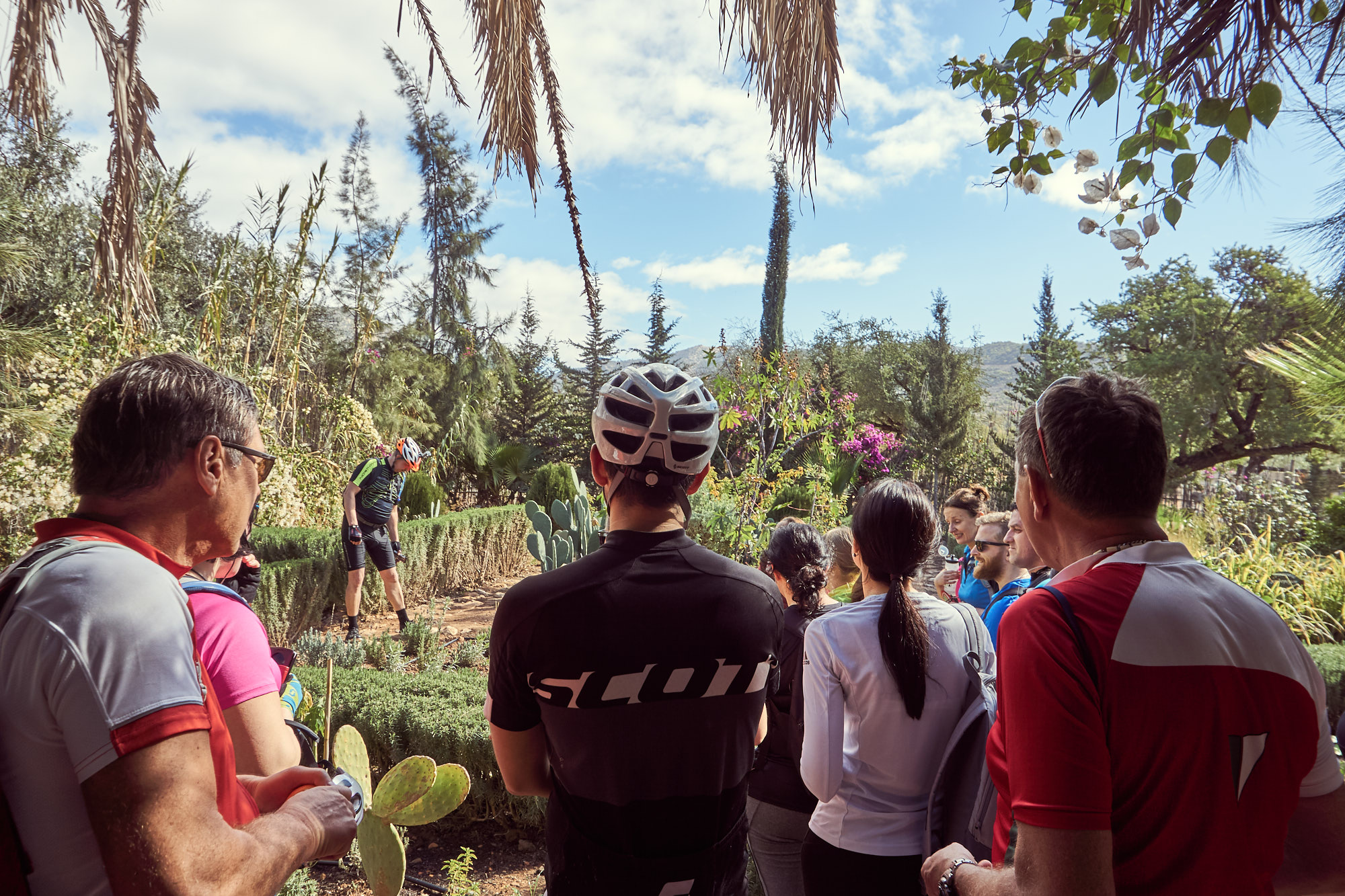
DAY 7
=> 5H ACTIVITIES FOR THE FREE DAY:
• 60 EUR | Agadir tour
• 50 EUR | Agadir by E-bike
• 40 EUR | Little Sahara (sandboarding)
• 45 EUR | Surfing / MTB cycling
=> 10H ACTIVITIES FOR THE FREE DAY:
• 60 EUR | Taroudant tour (100 km / 2.5 h one way)
• 70 EUR | Essaouira (170 km / 4 h one way)
• 70 EUR | Legzira (175 km / 4 h one way)
• 80 EUR | Marrakech (270 km / 5 h one way)
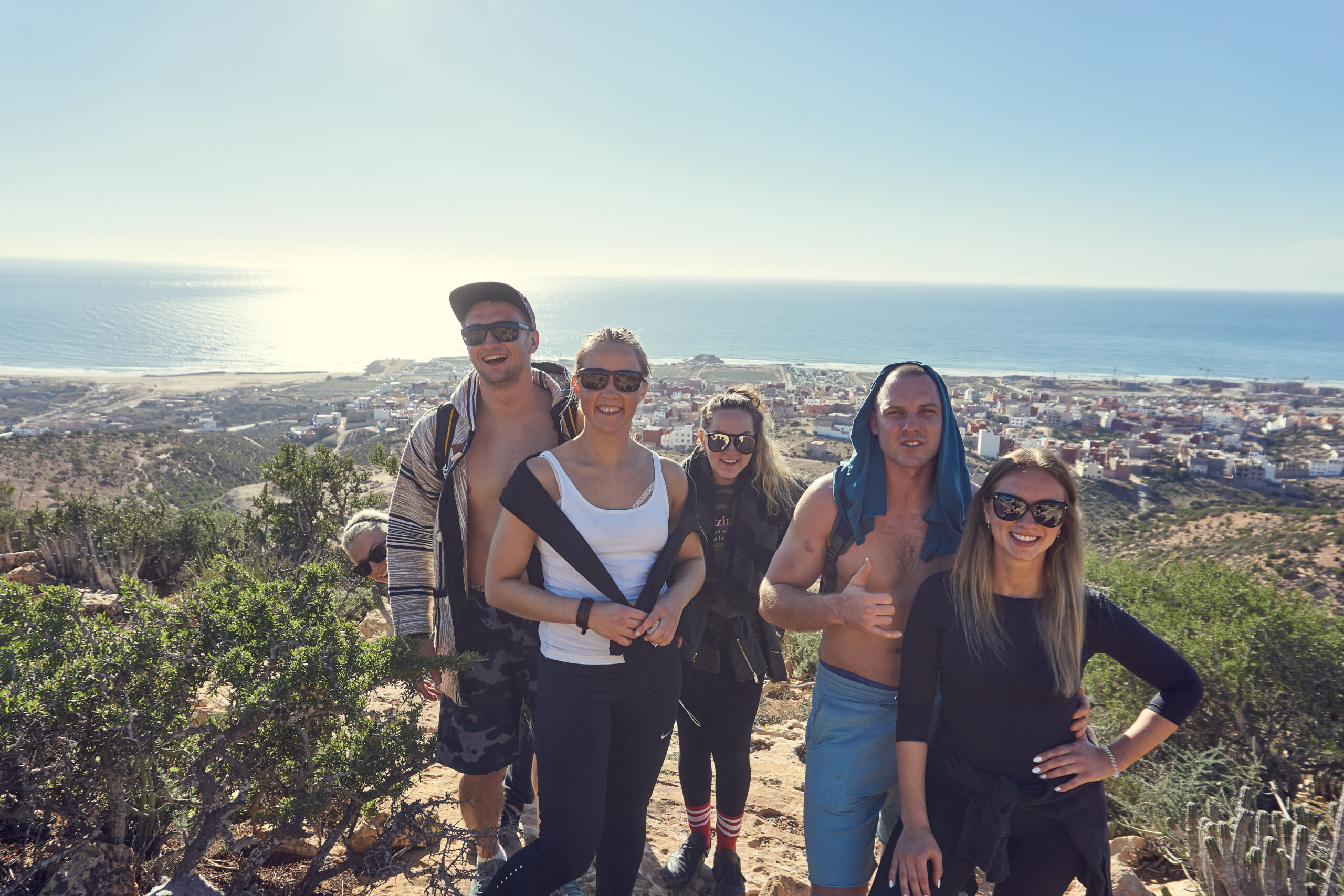
DAY 8
The daily schedule may be changed without prior notice.
The letters in brackets [ ] indicate the meals included on that particular day: B – breakfast, L – lunch, D – dinner.
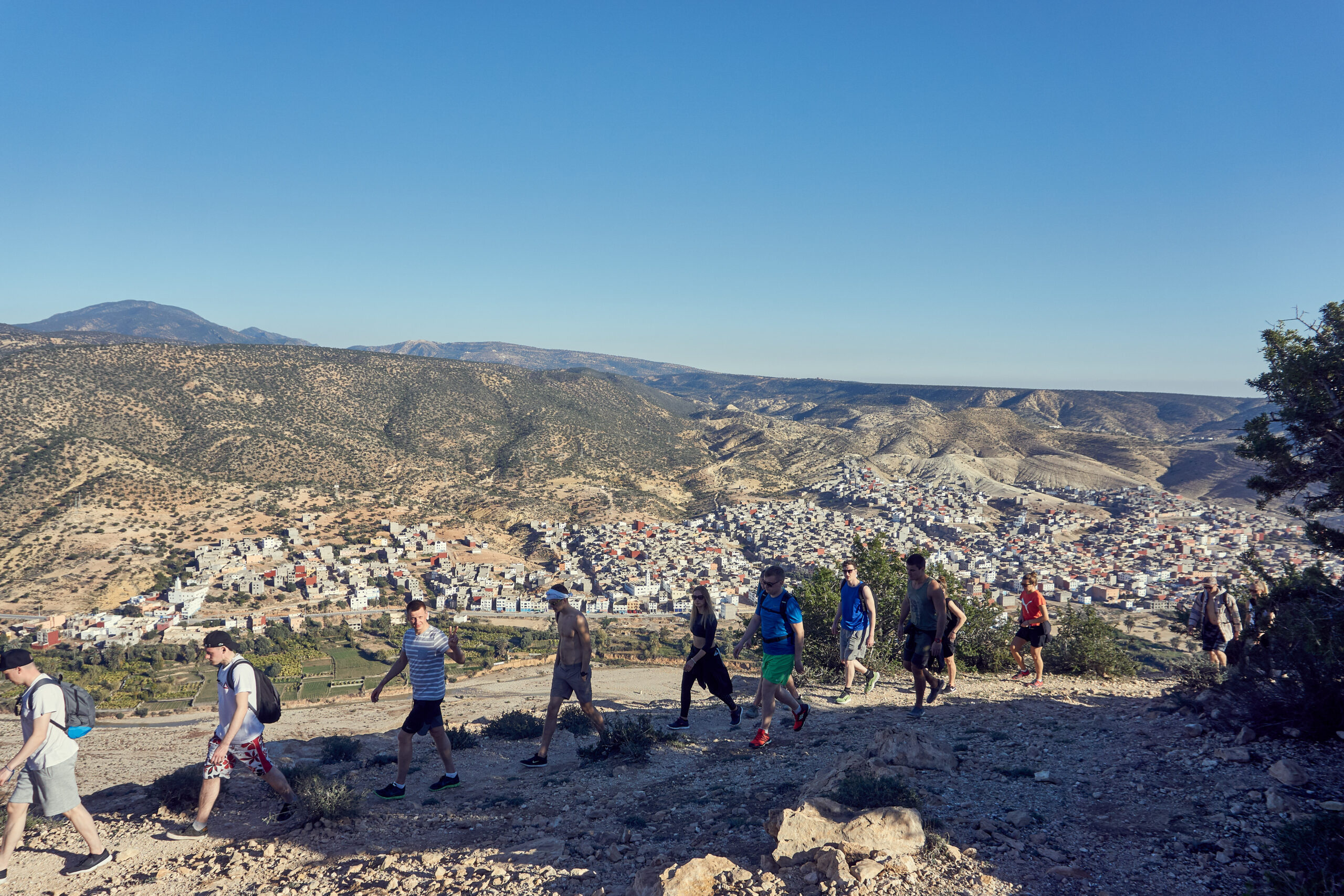
ACCOMMODATION
We live and base ourselves in Tamraght (Tagazote Bay), 15 km north of Agadir. Thanks to the warm sunny climate and constant waves, this place is considered one of the world’s best surfing resorts.
Right in the village center, we have a traditional three-story (each floor 100 m²) Moroccan family house.
The ground floor houses the kitchen and “staff only” rooms, while the second floor is fully arranged for guests.
The second (guest) floor has a separate entrance. It features two lockable bedrooms and one open-plan bedroom.
There is one lounge (living room), a shower room with toilet, one separate toilet, and two outdoor summer showers (and here summer is year-round). So in total: 3 bedrooms, 1 living room, 2 toilets, and 3 showers. Hot water (24/7) and internet are available.
Lockable bedrooms:
Small bedroom (9 m²) with one double bed (140 cm × 200 cm)
Medium bedroom (13 m²) with one large double bed (180 cm × 200 cm)
The large open-plan bedroom (separated from other rooms but without doors) is 14 m² with two bunk beds (4 beds total, each 90 × 190 cm). Toilets and showers are outside the bedrooms.
If needed, an extra bed can be added in the medium and large bedrooms.
This means the total guest capacity of the house is 10 people.
The third floor is a spacious (100 m²) rooftop terrace with views over the village and the Atlantic Ocean.
On the rooftop terrace, there is a sturdy wooden frame designed for TRX and AntiGravity suspension systems, allowing 14 people to train simultaneously and effectively.
On the ground floor outdoor terrace, there are sun loungers and a dining table with benches (most meals are eaten here). There is also a small gym corner with bars, dumbbells, medicine balls, and other equipment.
We live without luxury or flair but with everything needed for comfortable living—and, most importantly, just minutes’ walk from the Atlantic Ocean, in a place where summer lasts 365 days a year.
If you want to join our adventures but are not satisfied with these living conditions, please contact us.
There are many luxurious accommodation options in Tamraght and the surrounding area. For an extra fee, it is possible to stay in any other hotel or riad while enjoying the Moroccan adventures together with us.
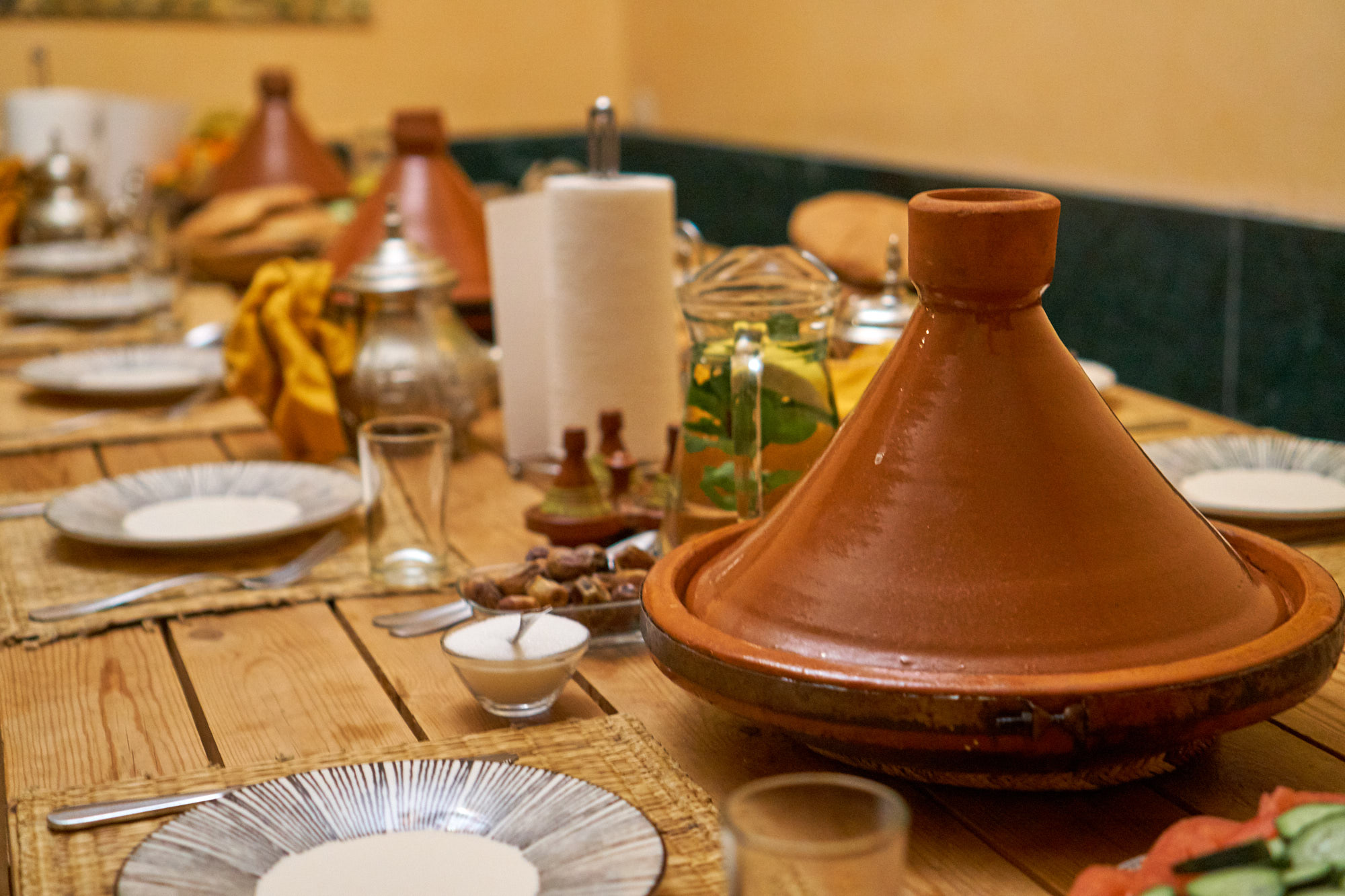
FOOD
All our meals are healthy, nutrient-rich, and made only from local ingredients—mainly vegetables, meat, or fish. During the week, every participant will have the opportunity to fully experience the variety of Moroccan cuisine and flavors. Here, every adventure seeker will eat well and heartily. We are friendly to vegans and vegetarians.
It’s worth noting that Morocco offers a delightful culinary adventure since traditionally meals are eaten by hand, using white bread as a tool.
Moroccan traditional breakfasts and dinners are homemade and served warm directly at the table to participants.
Lunches, on the other hand, are prepared fresh in the mornings at home, then packed into boxes for takeaway and enjoyed cold during the day.
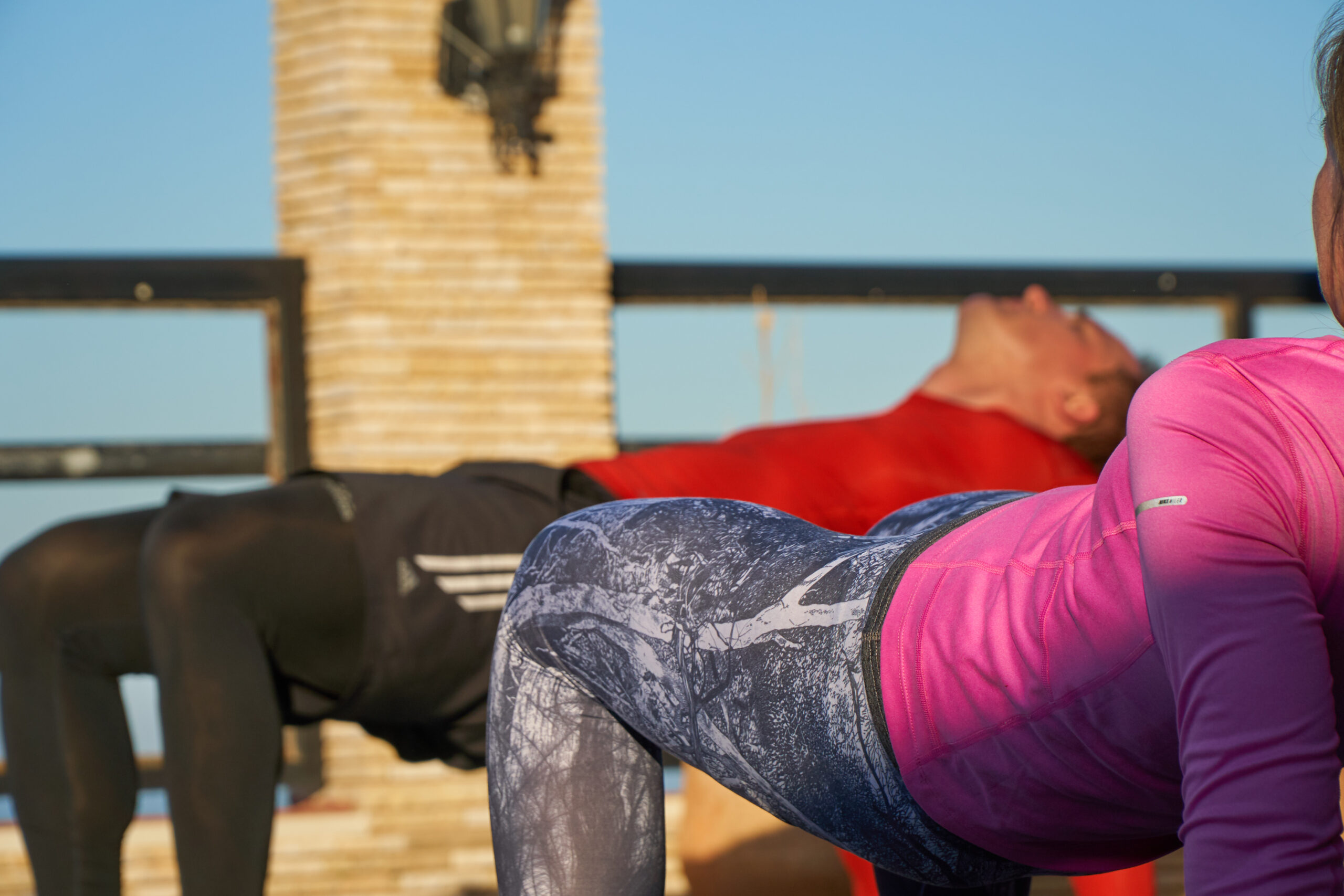
TRX & STRETCHING
For morning exercise, we allocate between 45 to 75 minutes, scheduled between sunrise and breakfast.
The session is divided into two parts: the first part (30–45 minutes) focuses on TRX*, followed by stretching for the second part (15–30 minutes).
Overall, this is not only a dynamic and invigorating workout to wake up your body and energize you for the day’s activities, but also a comprehensive training session that develops strength, balance, flexibility, and stability.
*TRX (Total Resistance Exercises) is a suspension training system with two adjustable straps, allowing you to perform (virtually endless) exercises using only your body weight as resistance. It effectively trains all major muscle groups, enhancing strength, flexibility, and balance.
These sessions are designed for everyone — no restrictions on gender, age, or fitness level.
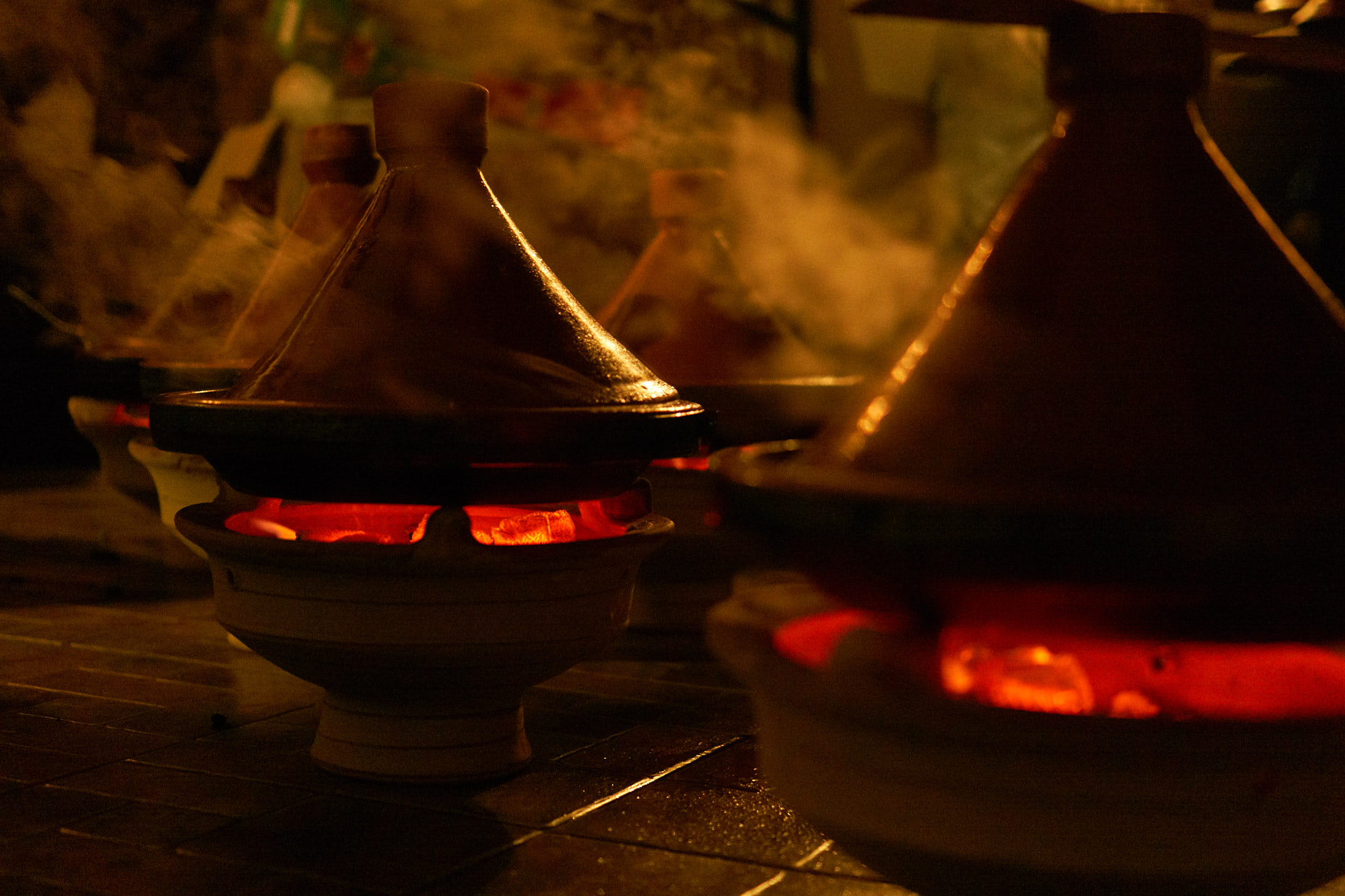
TAJINE COOKING CLASS
Tajine is a traditional Moroccan (and North African) dish — a slow-cooked stew made primarily with meat or fish, vegetables, nuts, dried fruits, and of course, Moroccan spices.
It’s usually served with bread and eaten by hand (without cutlery).
“Tajine” also refers to the special clay pot in which the dish is cooked. Its conical (sometimes dome or pyramid-shaped) lid traps steam and returns the condensed liquid back to the base (the plate), meaning only a minimal amount of water is needed to cook the dish.
Historically, this cooking method was crucial in regions where water was scarce or unavailable.
Every participant in our camp will have the opportunity to join a masterclass where several Moroccan tajines, Moroccan salads, and Moroccan tea (known as Berber whiskey) will be prepared.
At the end of the masterclass, we will enjoy together all the dishes we have cooked during a communal dinner.
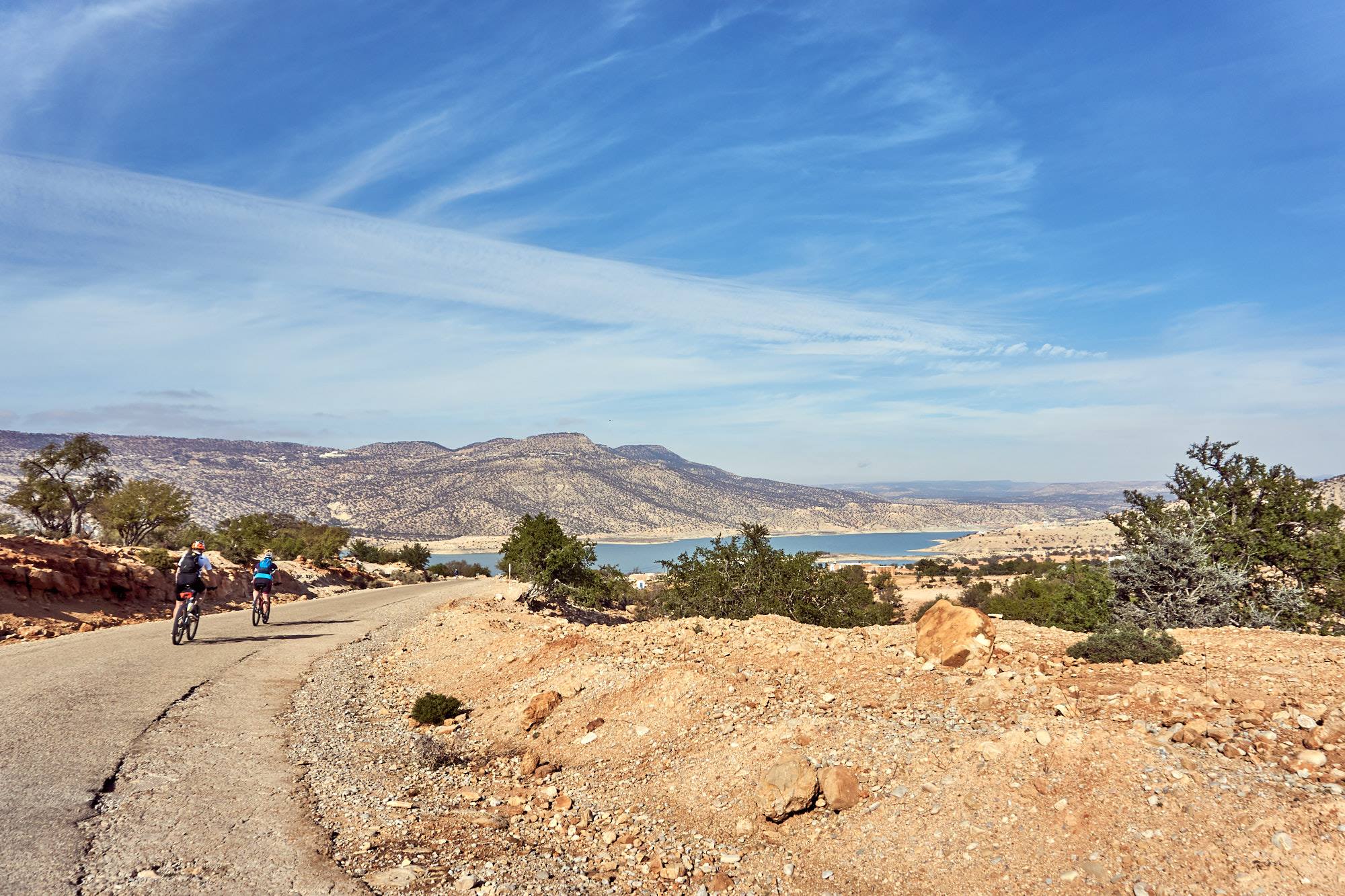
MOROCCAN BATH- HAMMAM
The traditional steam bath, or hammam, is an essential part of Moroccan culture and daily life, offering both physical and social benefits.
It’s a place not only to cleanse the body but also to relax, socialize, and experience a centuries-old ritual with origins tracing back to the Ottoman Empire.
A traditional Moroccan hammam visit consists of three main stages: relaxation (warming up); washing (soaping and scrubbing); and rinsing and cooling down.
Typically, a Moroccan hammam has three connected rooms with gradually increasing temperatures. The first, coolest room is around 30°C (86°F). The middle room is about 40°C (104°F), and the last, hottest room reaches approximately 50°C (122°F).
The warm, moist air helps open pores, relax muscles, and prepare the skin for cleansing.
Once the body is sufficiently warmed, the special Moroccan black soap called “sabon beldi” is applied, followed by scrubbing. These soaps contain olive oil and eucalyptus, which soften the skin. Using a special coarse glove called a “kese,” dead skin cells are exfoliated, leaving the skin fresh and smooth.
Next comes rinsing and cooling down. Water, carried in buckets since there are no showers, is slowly poured over the head and body using smaller buckets or cups. This rinsing continues until all soap is washed away.
After rinsing, the hammam ritual is officially complete. Visitors can leave or spend some more time relaxing in the coolest room, lying on the floor and unwinding.
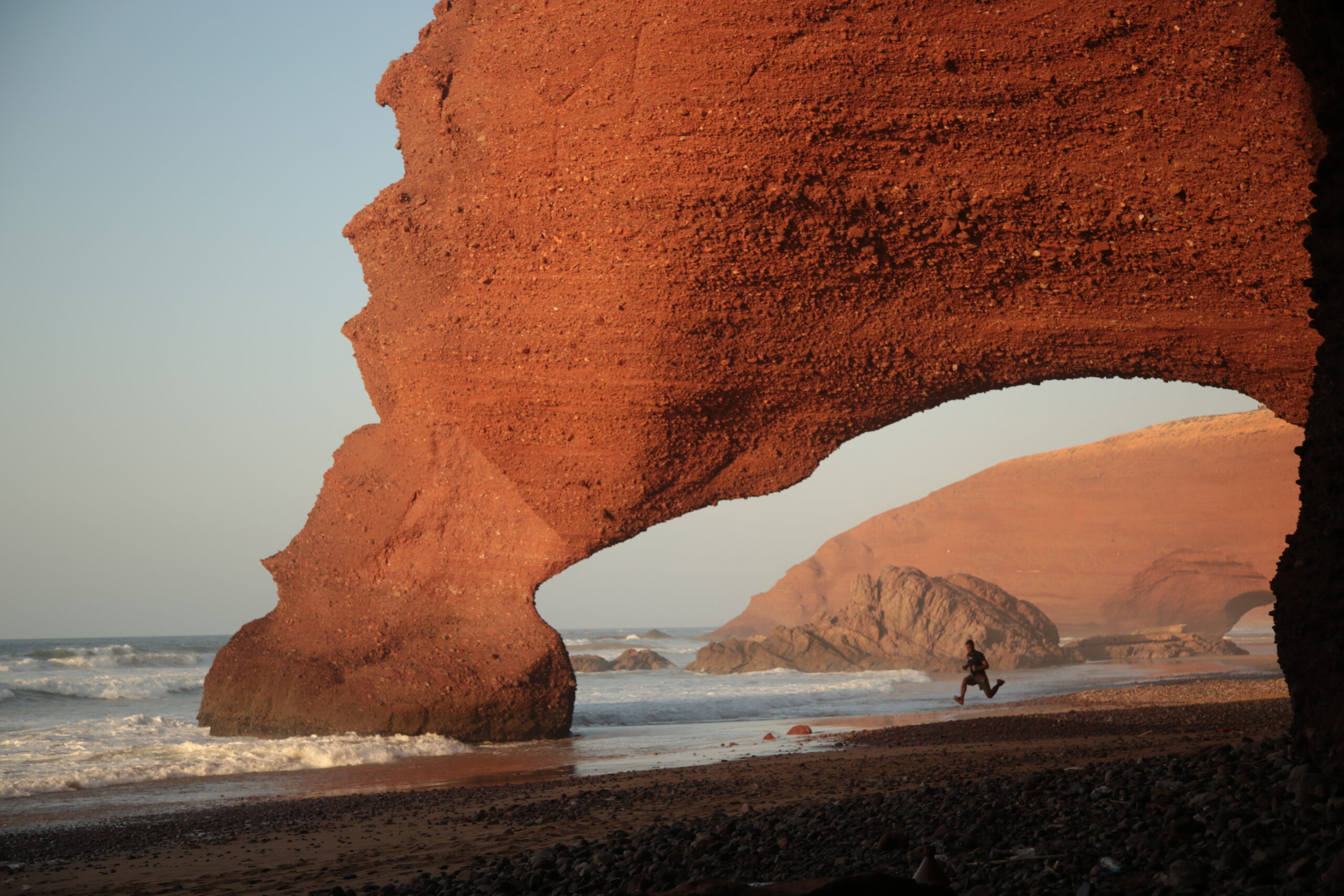
EXCURSIONS
AGADIR
Agadir is one of the most significant urban centers in Morocco and the country’s seventh-largest city. In 1960, a powerful earthquake struck Agadir, and the city was rebuilt according to strict seismic standards.
Today, Agadir is Morocco’s largest seaside resort, boasting a 10 km-long beach and one of the world’s best coastal promenades. The sun shines here 340 days a year, and swimming in the ocean is possible year-round. Importantly, winters are mild, and summers are warm but not excessively hot.
With its white buildings, wide flower-lined boulevards, modern hotels, and European-style cafes, Agadir is quite unlike the typical image of Morocco. It is a new, active, dynamic city focused on the future. Agadir is a major Moroccan tourist hub as well as the country’s most important fishing port.
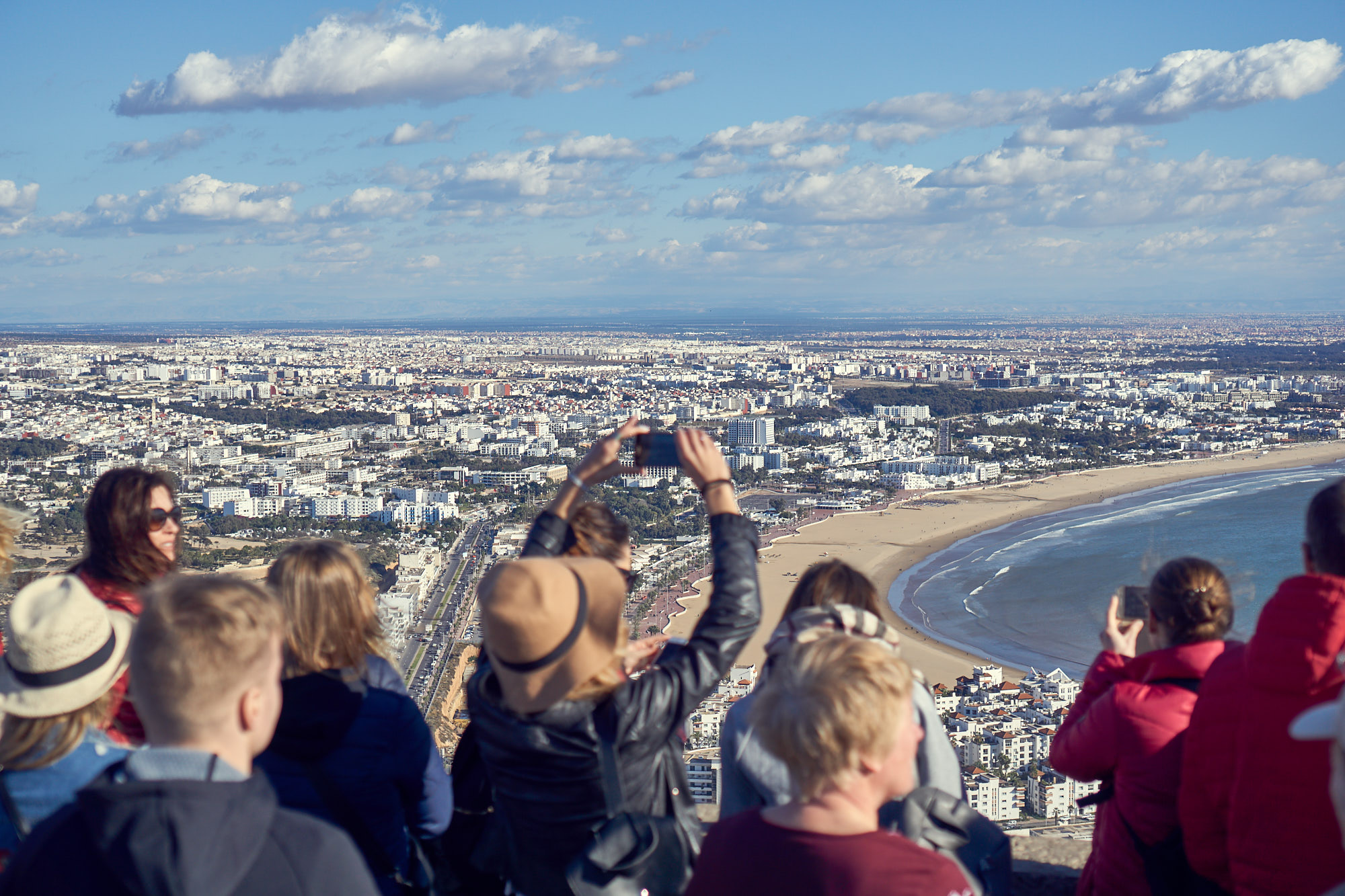
MARRAKECH
Marrakech is the fourth largest city in Morocco and arguably its most important former imperial capital. It encompasses the ancient fortified old town (medina) as well as the surrounding modern suburban areas. The old city walls are built from local reddish-orange clay and lime, which is why Marrakech is often called the “Red City.”
Here you’ll find Morocco’s largest traditional Berber market. The city’s landscape is inseparable from traders, snake charmers, acrobats, jugglers, street musicians, monkey trainers, storytellers, pickpockets, and jesters dressed in medieval costumes.
Today, Marrakech is one of the main tourist destinations and one of the liveliest cities in all of Africa.
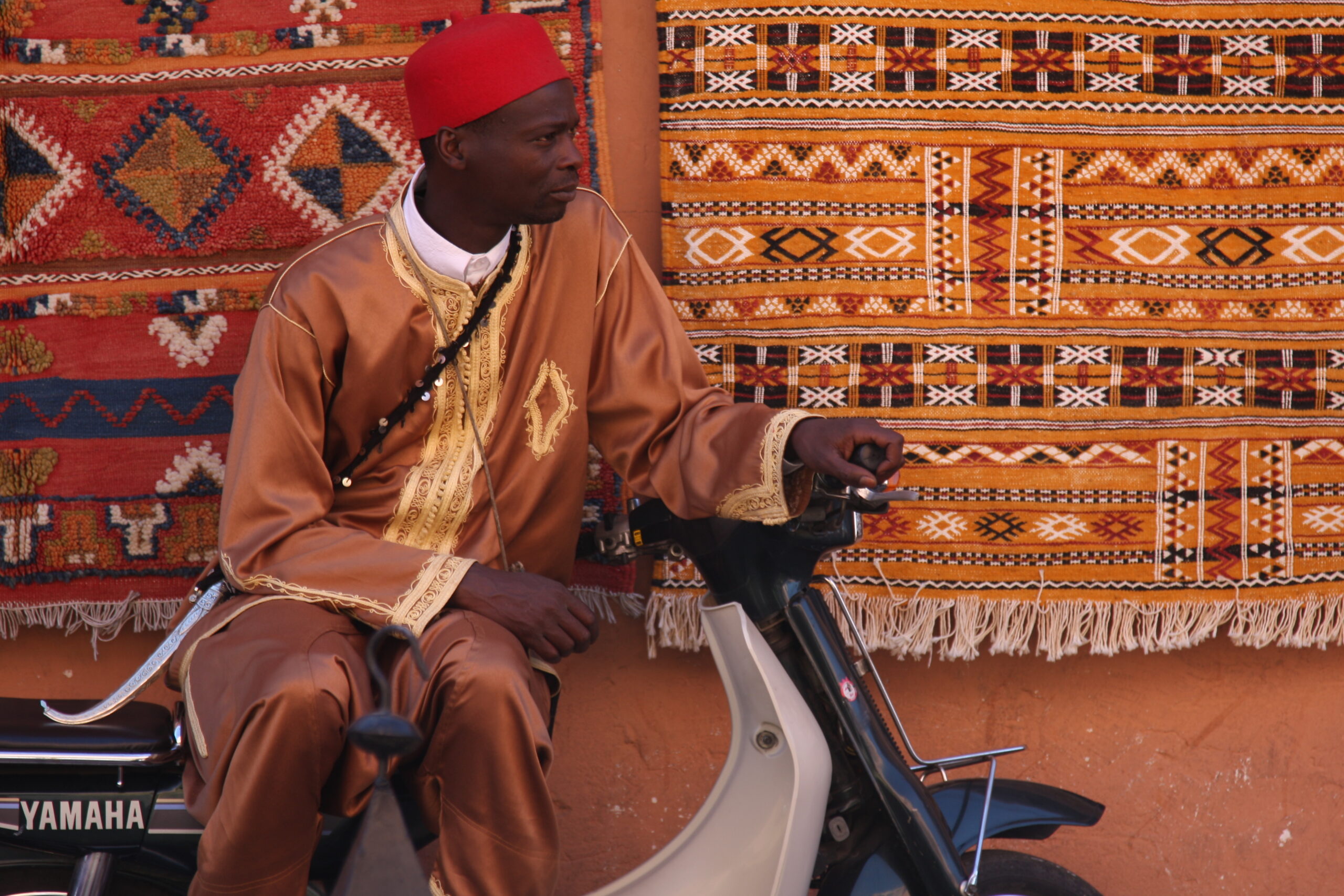
ESSAOUIRA
Essaouira (also known as the “Wind City”; its oldest name is Mogador) literally means “small bastion,” and part of the city is still surrounded by ancient defensive walls. The old town (medina) of Essaouira is listed as a UNESCO World Heritage site — a typical example of an 18th-century fortified city built in Africa by European colonizers.
Essaouira still hosts one of Morocco’s largest fishing ports. At the same time, it is a city rich in culture. Many artists and craftsmen live in Essaouira’s medina, creating unique chests, cabinets, and woodcarvings (using roots of the argan tree). These crafts have been practiced here for centuries. Small art galleries can be found throughout the city.
Since 1998, the annual ‘Gnawa World Music Festival’ takes place here every summer, featuring genres such as gnawa, rock, jazz, and reggae. The festival attracts artists from all over the world to Essaouira.
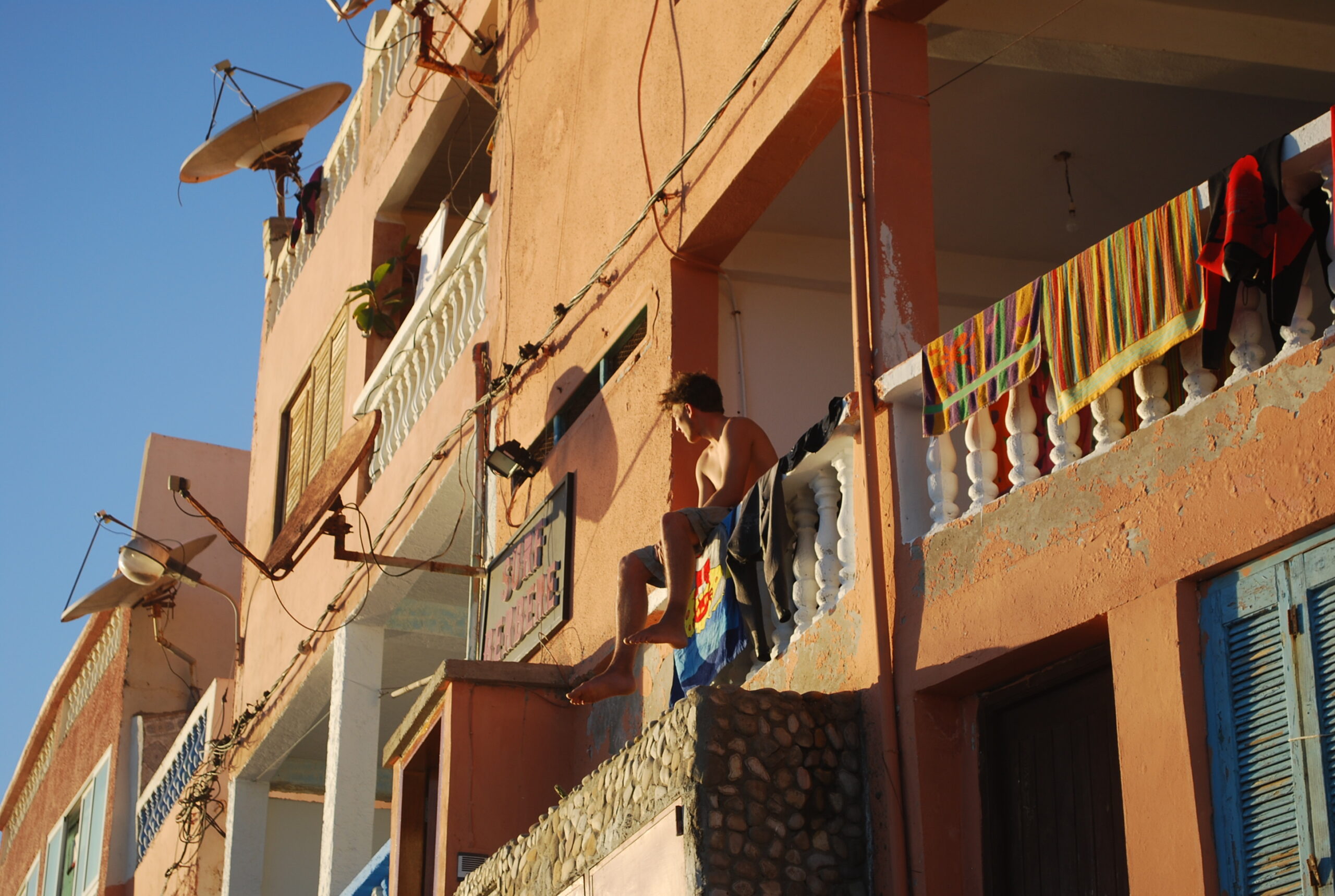
TAROUDANT
Taroudant is sometimes called the “grandmother of Marrakech” due to its ancient fortress walls, which, although somewhat smaller, resemble the defensive walls of Marrakech. In the 16th century, the ruling Saadian dynasty briefly used Taroudant as their capital before relocating it to Marrakech.
Today, Taroudant looks like a fortified trading town situated on an old caravan route. Unlike Marrakech, Taroudant is almost entirely enclosed within its city walls. Outside the walls, there is only a small leather workshop producing mainly camel saddle and riding accessories: goat leather goods, camel leather sandals, as well as leather bags and belts.
Taroudant is an important Moroccan trading town with markets around both of its city squares. The Berber market offers spices, dried fruits, clothes, and household items. Meanwhile, the Arab market specializes in iron, tin, and copperwork, pottery, ceramics, and also sells leather goods, rugs, blankets, and jewelry.
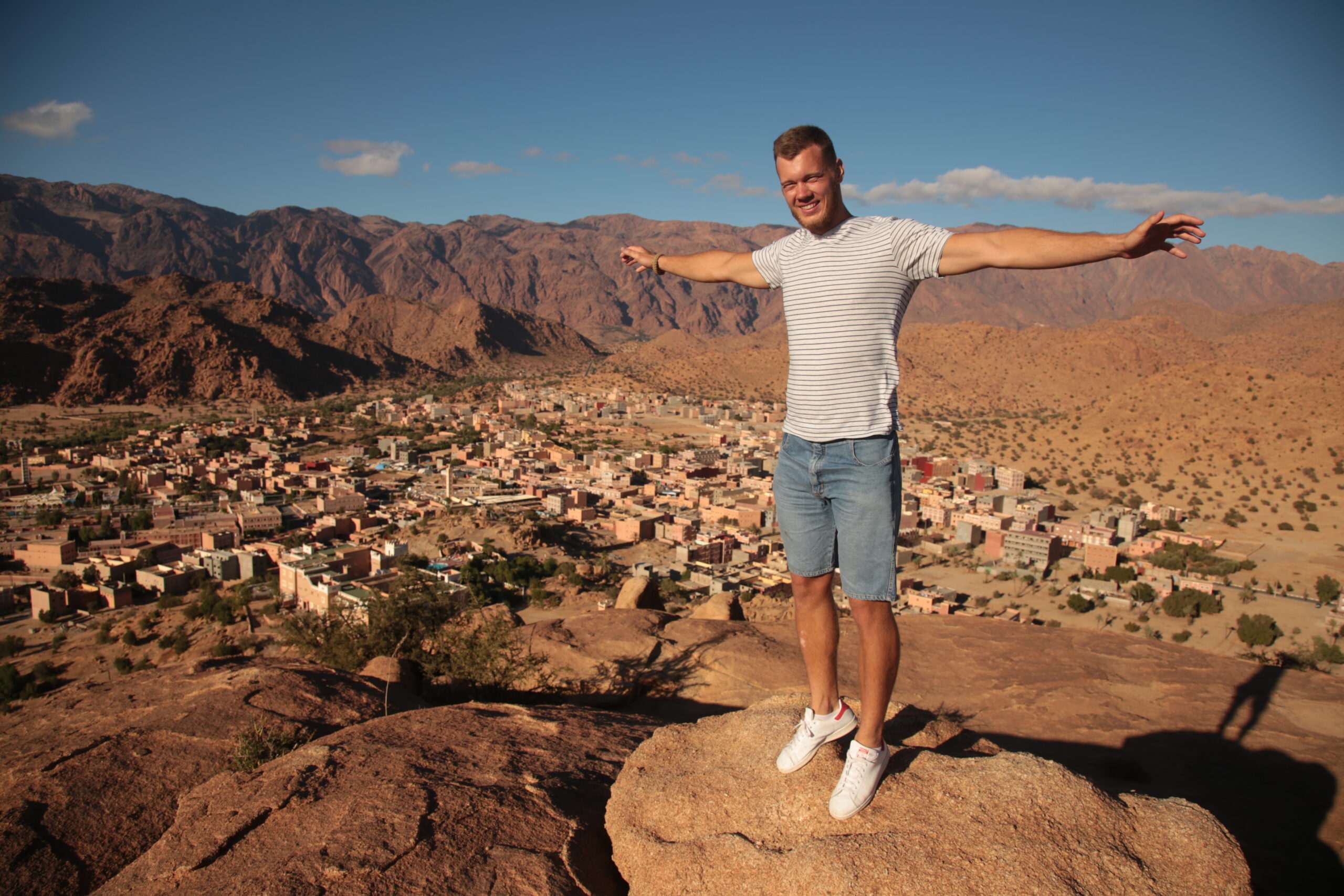
STAY LONGER
If 7 nights in Morocco is not enough, or if you can’t find flights that exactly match the camp’s official arrival and departure times, you can arrive earlier and/or leave later. Staying in the riad (including accommodation, meals, surfing, morning exercises, and excursions) outside the official dates of the surfing camp is available for an additional fee:
ACCOMMODATION
45 EUR* | standard double room
55 EUR* | deluxe double room
Price per room, 1 – 2 people;
25 EUR** | quadruple room
** Price per bed, per person.
MEALS
12 EUR | lunch or dinner
*Price per one meal, per person.
SURFING
45 EUR | 1 person
30 EUR | 2 people
25 EUR | 3 people
20 EUR | 4 people & more
All prices are per one lesson/set, per person. Instructor, transport, and equipment rental are included.
EQUIPMENT RENTAL
7 EUR | wetsuit
7 EUR | bodyboard
13 EUR | surfboard
25 EUR | SUP
25 EUR | bicycle
All prices are per one unit, per day. Instructor and transport are not included.
TRX & STRETCHING
30 EUR | 1 person
15 EUR | 2 people
10 EUR | 3 people & more
All prices are per one lesson, per person.
EXCURSIONS
80 EUR | Marrakech
70 EUR | Essaouira
60 EUR | Paradise Valley + Argan Oil Cooperative
60 EUR | Taroudant
50 EUR | Agadir
Excursions are organized upon request. The price for all excursions is stated per person, with the condition that at least 6 people participate. If there are fewer than 6 travelers, the price will be higher. Regardless of the number of travelers, lunch is included in the price.
TRANSFERS
20 EUR | Taghazout / Agadir
30 EUR | Agadir Airport
40 EUR | Paradise Valley
100 EUR | Essaouira / Taroudant
120 EUR | Marrakech
250 EUR | Casablanca
Transfers from or to Tamraght. All prices are per one vehicle (1 – 4 people), one way. For round-trip transfers, the price doubles.
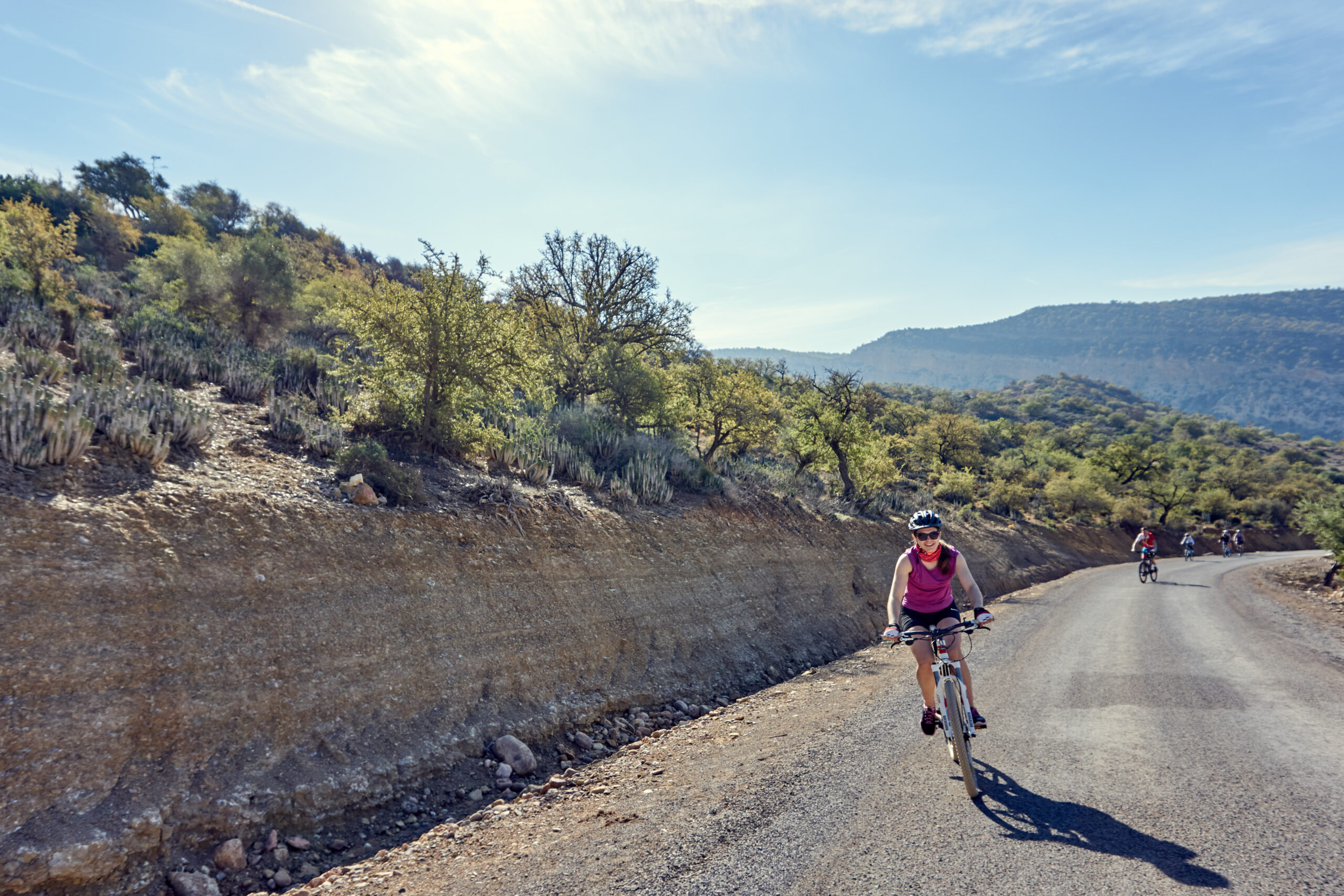
PLEASE NOTE
Citizens of European countries do not need a visa to travel to Morocco. The passport must be valid for at least 6 months after the planned end date of the trip.
Non-citizen passport holders require a visa to enter Morocco!
No special vaccinations are required before traveling to Morocco.
The national currency of the country is the Moroccan Dirham.
There are two ways to obtain it: the first is to bring cash in EUR, USD, or GBP and exchange it locally for Moroccan Dirhams (there are plenty of exchange offices available); the second is to bring your VISA or MASTERCARD bank card, from which you can withdraw cash at any ATM (paying by card directly is not possible). It is not recommended to buy (exchange) Moroccan Dirhams outside of Morocco!